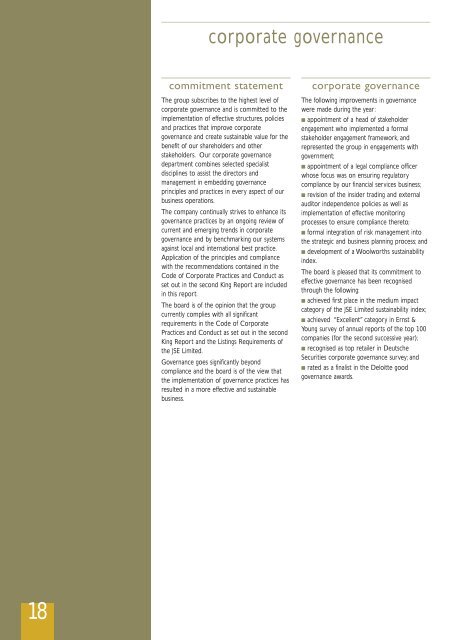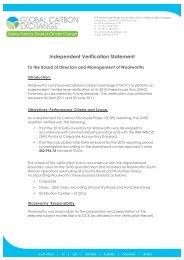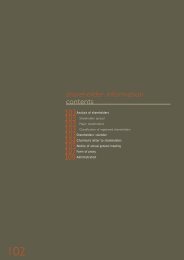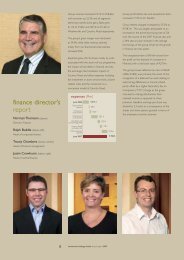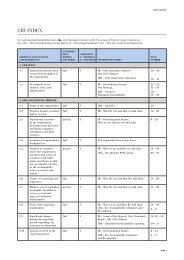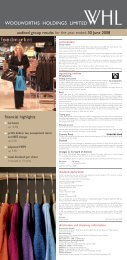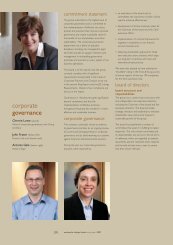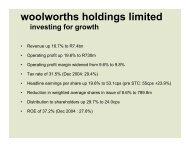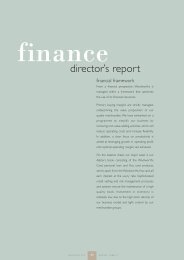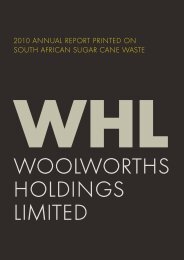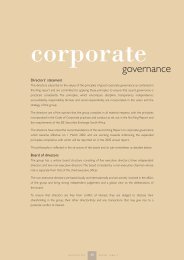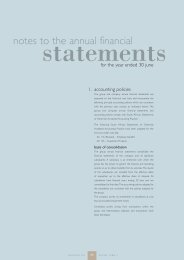corporate governance - woolworths holdings limited
corporate governance - woolworths holdings limited
corporate governance - woolworths holdings limited
You also want an ePaper? Increase the reach of your titles
YUMPU automatically turns print PDFs into web optimized ePapers that Google loves.
<strong>corporate</strong> <strong>governance</strong><br />
commitment statement<br />
The group subscribes to the highest level of<br />
<strong>corporate</strong> <strong>governance</strong> and is committed to the<br />
implementation of effective structures, policies<br />
and practices that improve <strong>corporate</strong><br />
<strong>governance</strong> and create sustainable value for the<br />
benefit of our shareholders and other<br />
stakeholders. Our <strong>corporate</strong> <strong>governance</strong><br />
department combines selected specialist<br />
disciplines to assist the directors and<br />
management in embedding <strong>governance</strong><br />
principles and practices in every aspect of our<br />
business operations.<br />
The company continually strives to enhance its<br />
<strong>governance</strong> practices by an ongoing review of<br />
current and emerging trends in <strong>corporate</strong><br />
<strong>governance</strong> and by benchmarking our systems<br />
against local and international best practice.<br />
Application of the principles and compliance<br />
with the recommendations contained in the<br />
Code of Corporate Practices and Conduct as<br />
set out in the second King Report are included<br />
in this report.<br />
The board is of the opinion that the group<br />
currently complies with all significant<br />
requirements in the Code of Corporate<br />
Practices and Conduct as set out in the second<br />
King Report and the Listings Requirements of<br />
the JSE Limited.<br />
Governance goes significantly beyond<br />
compliance and the board is of the view that<br />
the implementation of <strong>governance</strong> practices has<br />
resulted in a more effective and sustainable<br />
business.<br />
<strong>corporate</strong> <strong>governance</strong><br />
The following improvements in <strong>governance</strong><br />
were made during the year:<br />
■ appointment of a head of stakeholder<br />
engagement who implemented a formal<br />
stakeholder engagement framework, and<br />
represented the group in engagements with<br />
government;<br />
■ appointment of a legal compliance officer<br />
whose focus was on ensuring regulatory<br />
compliance by our financial services business;<br />
■ revision of the insider trading and external<br />
auditor independence policies as well as<br />
implementation of effective monitoring<br />
processes to ensure compliance thereto;<br />
■ formal integration of risk management into<br />
the strategic and business planning process; and<br />
■ development of a Woolworths sustainability<br />
index.<br />
The board is pleased that its commitment to<br />
effective <strong>governance</strong> has been recognised<br />
through the following:<br />
■ achieved first place in the medium impact<br />
category of the JSE Limited sustainability index;<br />
■ achieved “Excellent” category in Ernst &<br />
Young survey of annual reports of the top 100<br />
companies (for the second successive year);<br />
■ recognised as top retailer in Deutsche<br />
Securities <strong>corporate</strong> <strong>governance</strong> survey; and<br />
■ rated as a finalist in the Deloitte good<br />
<strong>governance</strong> awards.<br />
18
oard of directors<br />
board structure and responsibilities<br />
The group has a unitary board structure with<br />
seven independent non-executive directors and<br />
three executive directors. The board provides<br />
strategic direction and leadership and focuses<br />
on enhancement of shareholder value and the<br />
long-term sustainability of the group.<br />
The board has established a number of<br />
committees that assist it in fulfilling its stated<br />
objectives. The role of each committee and its<br />
responsibilities are set out in formal terms of<br />
reference, which are reviewed annually to<br />
ensure that they remain relevant.<br />
The chairman of each of the committees is an<br />
independent non-executive or the chairman of<br />
the board who is also classified as an<br />
independent non-executive director.<br />
board responsibilities<br />
The primary responsibilities of the board are<br />
set out in terms of a board charter, and ensure:<br />
■ that the company has a clear strategic<br />
direction and as part of this process reviews the<br />
progress made by the executive management<br />
against pre-agreed plans and budgets;<br />
■ that provision is made for succession at<br />
senior levels and that the group has a strong<br />
and motivated pool of talent;<br />
■ that our people subscribe to the values,<br />
which have always been fundamental to our<br />
culture;<br />
■ there are appropriate policies and processes<br />
to ensure the integrity of the company's risk<br />
management and internal controls;<br />
■ compliance with all relevant laws, regulations,<br />
and accounting principles;<br />
■ that the company acts responsibly to all our<br />
stakeholders including customers, employees,<br />
suppliers, franchisees, shareholders, government<br />
and the communities;<br />
■ the delegation of responsibilities to its<br />
committees and the determination of the terms<br />
of reference for such committees; and<br />
■ evaluation of its committees.<br />
There is a formal delegation of authority, which<br />
sets out the categories of business decisions,<br />
which require approval by the board and/or by<br />
one of its committees. Compliance with this<br />
delegation of authority is the responsibility of<br />
the board and is monitored by the Group<br />
secretary and the <strong>corporate</strong> <strong>governance</strong><br />
department.<br />
chairman and chief executive officer<br />
No individual has unfettered powers of<br />
decision-making.The responsibilities of the<br />
Chairman and the Chief executive officer are<br />
clearly separate.<br />
Buddy Hawton is an independent non-executive<br />
Chairman who is responsible for providing<br />
overall leadership of the board and ensuring<br />
that the board remains efficient and focused.<br />
The Chief executive officer, Simon Susman, is<br />
responsible for formulating and recommending<br />
strategies and policies to the board, and<br />
ensuring their implementation once approved.<br />
The Chairman, in conjunction with the<br />
nominations committee, assesses the<br />
performance of the Chief executive officer.<br />
board effectiveness<br />
The board through its nominations committee<br />
regularly reviews its size, required mix of skills,<br />
experience and other qualities. The board is<br />
comprised of local and international directors,<br />
who bring a blend of knowledge, skills,<br />
objectivity and a wide range of experience and<br />
commitment. A strong contingent of<br />
independent non-executive directors ensures<br />
that independent thought is brought to bear on<br />
the board decisions. The board structure and<br />
integrity of the individual directors ensures that<br />
no one individual or group dominates the<br />
decision-making process.<br />
In the 2005 financial year the board<br />
underwent an independent formal evaluation<br />
process, the results of which have been<br />
in<strong>corporate</strong>d into procedures adopted by the<br />
board. The next evaluation is scheduled for the<br />
2007 financial year.<br />
board structure<br />
unitary board<br />
Chairman:<br />
Buddy Hawton<br />
independent<br />
non-executive<br />
Six<br />
independent<br />
non-executive<br />
directors<br />
Three<br />
executive<br />
directors<br />
Risk committee<br />
Chairman:<br />
Mike Leeming<br />
and Members:<br />
two independent<br />
non-executive<br />
directors, three<br />
executive directors<br />
Audit<br />
committee<br />
Chairman:<br />
Mike Leeming<br />
and Members:<br />
two independent<br />
non-executive<br />
directors<br />
Remuneration<br />
committee<br />
Chairman:<br />
Buddy Hawton<br />
and Members:<br />
three independent<br />
non-executive<br />
directors<br />
Nominations<br />
committee<br />
Chairman:<br />
Buddy Hawton<br />
and Members:<br />
three independent<br />
non-executive<br />
directors<br />
Transformation<br />
committee<br />
Chairman:<br />
Chris Nissen<br />
and Members:<br />
three independent<br />
non-executive<br />
directors, one<br />
executive director<br />
19
directors<br />
An induction programme has been designed<br />
and is adjusted to meet the specific<br />
requirements of all new directors. The directors<br />
are provided with all the necessary<br />
documentation to familiarise them with issues<br />
affecting the board. In addition, they participate<br />
in an attachment programme with all the<br />
relevant executives, and undertake site visits to<br />
stores, suppliers and distribution centres to<br />
assist their understanding of the broad dynamics<br />
of the business. The Group secretary manages<br />
the formal induction programme. The board<br />
recognises that understanding the business is an<br />
ongoing process and as such, the Chairman of<br />
the board and the Group secretary ensure an<br />
appropriate quarterly programme is in place to<br />
update non-executive directors on key new<br />
business issues, initiatives and an update on<br />
operations and performance.<br />
In compliance with the second King Report an<br />
independent director must not be a<br />
representative of a shareholder with the ability<br />
to control or materially influence management<br />
and/or the board; not have been employed by<br />
the company in an executive role in the last<br />
three years; not have been an advisor to the<br />
company other than in the capacity as a<br />
director of the company; not be a material<br />
supplier, customer or have a material<br />
contractual relationship with the company; and<br />
be free of any relationship that could be seen<br />
to materially interfere with the independence of<br />
that person. All seven of the independent<br />
directors comply with these requirements.<br />
To uphold their independence and integrity,<br />
directors disclose all material interests on a<br />
regular basis and advise of any changes that may<br />
give rise to a potential conflict of interest and<br />
do not participate in any discussions and<br />
decisions on matters in which they may have a<br />
conflict of interest.<br />
The non-executive directors have unrestricted<br />
access to all company information, records,<br />
documents and property. Non-executive<br />
directors have access to management and may<br />
meet separately with management without the<br />
attendance of executive directors.<br />
Each quarter the non-executive directors meet<br />
together in a forum that does not include the<br />
executive directors or senior executives.<br />
The directors may at the expense of the<br />
company seek professional advice on matters<br />
concerning the affairs of the group. A policy has<br />
been formulated which contains guidelines on<br />
this matter.<br />
In accordance with the articles of association of<br />
the holding company, a third of the directors,<br />
are subject to retirement by rotation and reelection<br />
by shareholders each year. Directors<br />
who have held office for three years since their<br />
appointment or last election, are required to<br />
retire by rotation. The curriculum vitae of the<br />
directors standing for re-election are contained<br />
in the notice of the annual general meeting.<br />
board meetings<br />
The board meets at least four times a year.<br />
Additional meetings are held whenever deemed<br />
necessary. Further meetings were held in<br />
November, February and May and were<br />
devoted to strategic planning. In addition,<br />
regular teleconference meetings were held.<br />
Board meetings are scheduled well in advance<br />
and management ensures that board members<br />
are provided with all the relevant information<br />
and facts to enable the board to reach objective<br />
and well informed decisions. Board<br />
documentation is provided timeously to<br />
directors. The details of individual attendance at<br />
board and committee meetings are set out on<br />
page 31.<br />
group secretary<br />
The board is cognisant of the duties of the<br />
Group secretary and has created an<br />
environment in which the Group secretary is<br />
properly supported to fulfill those duties.<br />
The Group secretary plays a significant role in<br />
the following:<br />
■ induction of new directors;<br />
■ tabling to the board, relevant information on<br />
regulatory and legislative changes;<br />
■ guidance to directors individually and<br />
collectively on their duties and responsibilities to<br />
the company;<br />
■ providing guidance and advice to the board<br />
on matters of ethics and good <strong>governance</strong>; and<br />
■ providing the communication link with<br />
investors, shareholders and with the company’s<br />
share registrars.<br />
The Group secretary acts as secretary for the<br />
committees of the board.<br />
The directors have un<strong>limited</strong> access to the<br />
advice and services of the Group secretary.<br />
board committees<br />
During the 2005 financial year members of the<br />
risk, audit, nominations and remuneration<br />
committees evaluated their effectiveness<br />
through a self-assessment process conducted by<br />
means of a questionnaire. The committees’<br />
composition and structure, procedures, terms of<br />
reference, effectiveness and leadership were<br />
analysed. The results of the analysis were used<br />
to further improve the effectiveness of the<br />
committees’ functioning. Committee evaluations<br />
have been planned for the 2007 financial year.<br />
The Chief executive officer attends all the<br />
committee meetings of which he is not a<br />
member by invitation. This demonstrates the<br />
commitment to <strong>corporate</strong> <strong>governance</strong> within<br />
the group.<br />
The committees have unreserved access to<br />
company information, any resources required to<br />
fulfill their responsibilities and are able to obtain<br />
professional advice, at the expense of the group,<br />
where necessary.<br />
20
isk committee<br />
The risk committee consists of three executive<br />
directors and three non-executive directors<br />
including the chair Mike Leeming. The presence<br />
of the executive directors on this committee is<br />
deemed important in ensuring that effective risk<br />
management is in place and part of the day-today<br />
operation of the company.<br />
The responsibilities of the committee are set<br />
out in its terms of reference which is reviewed<br />
and updated on an annual basis. The main<br />
responsibilities include:<br />
■ assisting the directors in fulfilling their<br />
responsibility of ensuring that there is an<br />
effective and embedded risk management<br />
process in place throughout the group;<br />
■ assessing whether there are appropriate<br />
processes/controls in place to manage the key<br />
risks down to an acceptable level, in line with<br />
the board's risk appetite;<br />
■ assessing if the risk management process will<br />
ensure that emerging risks are identified and<br />
managed;<br />
■ assessing whether all new business<br />
opportunities have been appropriately<br />
considered from a risk perspective;<br />
■ assessing if appropriate processes/controls are<br />
in place to ensure regulatory compliance; and<br />
■ reviewing the adequacy of the group’s<br />
insurance portfolios.<br />
Based on a review of management reports and<br />
appropriate discussion and enquiry by the<br />
members, the committee believes that it<br />
performed the functions set out in its terms of<br />
reference and continues to identify and<br />
prioritise the risks relevant to the business.<br />
The committee met a total of four times during<br />
the year. The details of individual attendance at<br />
the risk committee meetings are set out on<br />
page 31.<br />
The Chairman attends the meetings in February<br />
and August following the group’s financial half<br />
year and year end.<br />
risk management<br />
The board recognises risk management as a key<br />
business tool, which is designed to:<br />
■ balance risk and reward within both existing<br />
and new businesses; and<br />
■ protect the group against uncertainties and<br />
hazards, which could prevent the achievement<br />
of business objectives.<br />
The board is responsible for the risk<br />
management process and is assisted in its<br />
responsibilities by the risk committee. The dayto-day<br />
responsibility for risk management and<br />
the design and implementation of appropriate<br />
processes to manage the risks resides with<br />
management.<br />
The risk management process is effective and<br />
adds value to the group by:<br />
■ improving the quality of business decisions,<br />
through a more formal identification and<br />
assessment of risk before new business ventures<br />
and/or projects are presented for approval; and<br />
■ contributing to an improvement in the<br />
processes and controls in place to manage the<br />
key risks.<br />
The risk management process applied is<br />
designed to ensure that:<br />
■ all relevant risks are identified and<br />
appropriately evaluated, based on their impact if<br />
they were to occur and their likelihood of<br />
occurrence;<br />
■ risks and the required processes and controls<br />
to manage these risks are assessed in line with<br />
the board’s risk appetite; and<br />
■ appropriate management information and<br />
monitoring processes are in place to manage<br />
the exposure to each of the key risks, so that<br />
where required appropriate corrective action<br />
can be taken.<br />
The focus for the year was to integrate risk<br />
management with the strategic and business<br />
planning process. This has further embedded<br />
risk management into our established business<br />
disciplines, as has the definition and<br />
measurement of objective metrics, to assess our<br />
exposure to the key risks. During the year:<br />
■ each business unit updated their business risk<br />
profile during their strategic and business<br />
planning. The purpose was to identify key risks<br />
linked to the strategy and our business model<br />
and the required processes and controls to<br />
manage these risks over the next three years;<br />
■ the key inherent risks for the group were reevaluated,<br />
based on the revised business unit<br />
profiles and a reassessment of the prior year<br />
key inherent risks; and<br />
■ the required management information and<br />
metrics to objectively assess our exposure to<br />
the key risks were clearly defined.<br />
The key inherent risks and their status are<br />
reported to the risk committee on a quarterly<br />
basis. This report is complemented by risk<br />
reports on specific focus areas including, crisis<br />
management, business continuity planning,<br />
disaster recovery, food safety and quality,<br />
occupational health and safety, legal risk<br />
management and insurance.<br />
21
management of our key risks<br />
The revision of the key inherent risk profile<br />
for the group reflected the dynamic nature of<br />
risk management and the effectiveness of the<br />
process within the group. A number of the<br />
key risks from the prior year are now being<br />
managed in a more effective manner and as<br />
such no longer require monitoring by the<br />
board.<br />
In the prior year a key risk was the<br />
implementation of the Retek merchandise<br />
management system. This implementation<br />
represented a significant investment and<br />
required a redesign of a number of key business<br />
processes. This implementation has had an<br />
impact on the business during the current year,<br />
but a number of financial benefits have already<br />
been realised, particularly with respect to more<br />
effective stock planning. The implementation is<br />
at an advanced stage and as such the risk to the<br />
business has reduced and we now need to<br />
leverage this investment to deliver the expected<br />
stock management benefits.<br />
There are also a number of areas where the<br />
processes and controls have been enhanced to<br />
improve the management of our risks as set out<br />
below.<br />
clothing product<br />
The ongoing implementation of our design-led<br />
process throughout the clothing groups has<br />
enhanced our product offering and ensured a<br />
more consistent taste level. The improvement<br />
in our product offering has been supported by<br />
the use of innovative technology and effective<br />
sourcing. Given the progress made, the risk of<br />
having an inappropriate clothing offering has<br />
reduced but this is an area which requires<br />
ongoing attention.<br />
key suppliers<br />
Woolworths is essentially a private label<br />
business and as such there is a key dependency<br />
on our suppliers. This is an inherent risk but<br />
during the year we rationalised our supplier<br />
base and implemented more formal processes<br />
to assess the capacity of suppliers to meet our<br />
volume requirements, whilst ensuring our high<br />
quality standards are maintained.<br />
business continuity planning<br />
We have continued to improve the continuity<br />
plans in place to maintain service levels and<br />
ensure rapid recovery in the event of a disaster<br />
at any one of our operations. These plans are<br />
formalised, well communicated and are tested<br />
on a regular basis. Therefore, given the<br />
processes in place this is now regarded as a<br />
low risk.<br />
food safety<br />
Food safety is a critical area to ensure we<br />
protect our customers. To enhance our<br />
processes, we redesigned our product recall<br />
process during the year to ensure that any<br />
product which could cause serious harm to our<br />
customers is removed from our stores and<br />
destroyed timeously. This process was formally<br />
tested twice during the year and these tests<br />
were used to further refine the process.<br />
Whilst management has improved the control<br />
environment to more effectively manage a<br />
number of the key risks, the environment in<br />
which we trade is dynamic. Therefore there are<br />
certain new risks which require focus, including:<br />
■ the proposed implementation of quotas on<br />
goods imported from China;<br />
■ compliance to the Credit Act; and<br />
■ armed robbery.<br />
key risk profile<br />
Our key risks have been set out below.<br />
proposed implementation of quotas<br />
The government is proposing the<br />
implementation of quotas on goods imported<br />
from China. This could have a significant impact<br />
on our abiliy to provide the right quality<br />
products at good value, dependent on the<br />
mechanism of implementation.<br />
ensuring the correct product offering<br />
Our aim is to nurture and build lifetime<br />
relationships with our customers and to achieve<br />
this we need the correct product offering. This<br />
means we need to continue to provide<br />
innovative, high quality products for our<br />
customers, which are competitively priced.<br />
Within clothing, the implementation of the<br />
design-led process in womenswear contributed<br />
to good growth. This process is being<br />
implemented in the other clothing groups and<br />
has now resulted in an improvement in the<br />
clothing offering.<br />
Our food product offering continues to provide<br />
real differentiation and there has been excellent<br />
growth.<br />
credit risk<br />
The value of the instore card, personal loans<br />
and credit card books has continued to grow.<br />
These assets support the ongoing growth in our<br />
retail business and create significant revenue for<br />
the group. However, there is a risk that<br />
customers may default on their payments with<br />
a consequential impact on the level of debt<br />
write-offs<br />
delivery of the real estate plan<br />
A key success factor in maintaining our growth,<br />
particularly in the food business, is selecting<br />
appropriate locations and formats for our<br />
stores. There is a risk that we are unable to<br />
source appropriate sites, which deliver the<br />
required rates of return and maintain our<br />
profitable growth.<br />
The new stores continue to meet the required<br />
hurdle rates of return. However, it has been<br />
recognised that each new store opening<br />
requires close management involvement to<br />
ensure that the catalogue and product offering<br />
is correct.<br />
attraction and retention of talent<br />
In order to deliver our strategy and manage the<br />
key risks, it is important to attract and retain the<br />
right combination of technical and leadership<br />
skills. This is a challenge in a number of<br />
specialist areas including design and buying,<br />
property development, credit risk and store<br />
management.<br />
During the year we recruited certain key talent<br />
within the clothing group with a focus on<br />
design, technology and stock management skills.<br />
This has assisted in the repositioning of our<br />
clothing offering.<br />
There was an investment made to ensure that<br />
we could recruit and retain store management<br />
and this resulted in a significant decrease in the<br />
level of store management vacancies.<br />
22
customer service<br />
Our customers' expectations continue to<br />
increase and we are committed to<br />
understanding and meeting their expectations.<br />
Our customer service trial demonstrated that<br />
the key requirement is to ensure product<br />
availability throughout our trading period. In<br />
addition, the length of till queues requires<br />
attention to ensure that our customers enjoy<br />
their shopping experience.<br />
compliance with the new Credit Act<br />
The new Credit Act has been promulgated and<br />
we need to comply with the requirements from<br />
the effective date of 1 July 2007.<br />
Compliance to the Credit Act will require<br />
enhancements to our current business process<br />
and system design.<br />
armed robbery<br />
We are concerned with the increasing level of<br />
armed robbery affecting retail stores. In the<br />
2006 financial year there were fifteen armed<br />
robberies in our stores, compared to seven in<br />
the prior year. Whilst we were fortunate during<br />
the year that none of our employees or<br />
customers were seriously injured, the increase<br />
in armed robbery represents a real threat to<br />
safety.<br />
Over and above the processes and controls in<br />
place to manage our key risks, the group has a<br />
comprehensive asset and liability insurance<br />
programme.<br />
crime prevention and detection<br />
A key priority is the implementation of effective<br />
processes to reduce the level of crime, which<br />
includes shrinkage, burglary, armed robbery,<br />
internal fraud, theft and corruption. Armed<br />
robbery has now been identified as a key risk<br />
given the increasing levels and the threat to<br />
employee and customer safety. Measures are in<br />
place to manage this as reported under our key<br />
risks.<br />
With respect to fraud, theft and corruption we<br />
have continued to build on our progress and<br />
during the year we:<br />
■ extended the scope of our independent and<br />
confidential shrinkage hotline, to include fraud,<br />
theft and unethical practices;<br />
■ completed several investigations which<br />
resulted in disciplinary action and criminal<br />
charges being laid. This demonstrates our<br />
commitment and where required the results of<br />
the investigations are used to improve the<br />
control environment; and<br />
■ commenced the implementation of fraud risk<br />
assessments to identify our fraud risk and<br />
ensure appropriate controls are in place.<br />
23
24<br />
audit committee<br />
The audit committee consists of three<br />
independent non-executive directors including<br />
Mike Leeming, who chairs the committee.<br />
The terms of reference of the audit committee<br />
were reviewed and updated to ensure the<br />
committee is effective in its monitoring role.<br />
The Chairman of the audit committee attends<br />
the annual general meeting.<br />
The main responsibilities of the committee set<br />
out in the terms of reference include:<br />
■ assisting the directors in fulfilling their<br />
responsibilities for ensuring that there is an<br />
adequate and effective system of internal<br />
control in place and that the assurance<br />
providers are operating effectively;<br />
■ review of the accounting policies and<br />
practices and all proposed changes thereto;<br />
■ facilitating the credibility, objectivity and<br />
reliability of published financial reports and<br />
ensuring that financial statements comply with<br />
the International Financial Reporting Standards;<br />
■ providing an objective, independent forum for<br />
the resolution of significant accounting and<br />
reported related matters;<br />
■ approval of engagement of external auditors,<br />
for non audit services;<br />
■ supporting the overall effectiveness of<br />
<strong>corporate</strong> <strong>governance</strong> processes; and<br />
■ considering and making recommendations to<br />
the board on the following:<br />
■ the appointment and retention of external<br />
auditors;<br />
■ external audit fees;<br />
■ interim and annual report financial<br />
disclosure;<br />
■ effectiveness of liaison between assurance<br />
providers; and<br />
■ effectiveness of internal audit.<br />
Separate meetings are held with the external<br />
auditors to ensure that matters are considered<br />
without undue influence. In addition, the board<br />
has approved an external auditor independence<br />
policy, which provides guidelines where<br />
management wishes to engage the external<br />
auditors for non audit services. Compliance<br />
with this policy is monitored and reported to<br />
the committee on a quarterly basis.<br />
There is a strong integration and co-ordination<br />
between the activities of the risk and audit<br />
committees and Mike Leeming and Nigel Colne<br />
are members of both committees to ensure the<br />
appropriate exchange of key ideas.<br />
Based on a review of management and audit<br />
reports and appropriate discussion and enquiry<br />
by the members, the committee believes that it<br />
performed the functions set out in its terms of<br />
reference.<br />
The committee met a total of four times during<br />
the year. The details of individual attendance at<br />
the audit committee meetings are set out on<br />
page 31.<br />
The Chief executive officer, the Finance director,<br />
the external auditors, and the Head of risk and<br />
audit attend the meetings as invitees.<br />
The Chairman attends the meetings in February<br />
and August following the group’s financial half<br />
year and year end.<br />
internal control<br />
The board is accountable for the group’s system<br />
of internal control and has delegated this<br />
responsibility to management.The system of<br />
internal control is designed to ensure that the<br />
significant risks are being appropriately managed<br />
and provide reasonable assurance that:<br />
■ business objectives will be achieved in normal<br />
and adverse trading conditions;<br />
■ operations are efficient and effective;<br />
■ management information is reliable;<br />
■ company assets and information are<br />
appropriately safeguarded; and<br />
■ there is compliance with applicable laws and<br />
regulations.<br />
The board recognises the importance of the<br />
control environment in ensuring the<br />
effectiveness of internal controls. As such there<br />
is an ongoing focus to ensure that roles and<br />
responsibilities are clearly defined and that<br />
management are held accountable for<br />
compliance with the key processes and controls.<br />
assurance providers<br />
To assist management and the audit committee<br />
in forming their opinion on the adequacy and<br />
effectiveness of internal controls, there are a<br />
number of assurance processes in place.These<br />
assurance processes are outlined in more detail<br />
below.<br />
control self-assessment<br />
Within key business areas such as retail<br />
operations and logistics there are regular<br />
management control self-assessment processes<br />
in place.The purpose of these self-assessments<br />
is to ensure that there is compliance with the<br />
key internal controls, from both an operational<br />
and financial perspective.The results of the selfassessments<br />
are summarised in the monthly<br />
business unit scorecards and are reviewed by<br />
management.<br />
internal audit<br />
The objective of internal audit is to provide<br />
independent assurance that there are adequate<br />
and effective processes and controls in place to<br />
manage the significant risks down to an<br />
acceptable level.<br />
In addition to providing this fundamental<br />
assurance, internal audit uses its risk and control<br />
knowledge to advise management on best<br />
practice processes and controls that can be<br />
implemented to improve the control<br />
environment in a meaningful and sustainable<br />
manner.<br />
Internal audit remains a highly valuable and<br />
effective monitoring activity, which is utilised by<br />
both directors and management to ensure that<br />
appropriate and cost effective controls are in<br />
place and complied to.<br />
The key elements that have contributed to the<br />
effectiveness of internal audit are:<br />
■ risk based planning: The audit plan is based<br />
on an independent assessment of the risks and<br />
is reviewed and approved by the audit<br />
committee in May of each year. However, whilst<br />
the plan is annual it is revised quarterly to take<br />
cognisance of any changes within the risk<br />
environment and these changes are approved<br />
by the committee;<br />
■ people: The audit team has a wealth of<br />
business and audit knowledge, which is<br />
leveraged by working within multi-disciplinary<br />
teams, to enhance the quality of the audit<br />
opinion and associated recommendations; and<br />
■ reporting: Key audit findings are reported to<br />
the audit committee each quarter in the red<br />
flag report. This report sets out the significant<br />
areas of concern in the control environment<br />
and defines the required controls which should<br />
be implemented. Progress in implementing the<br />
required controls to address these red flag<br />
items is audited quarterly and the results are<br />
reported to the committee until the item has<br />
been satisfactorily resolved. This enables the<br />
committee to ensure that prompt action has<br />
been taken to address the key areas of concern.<br />
The board has recognised that to be truly<br />
effective internal audit needs to remain<br />
independent and objective. As such the Head<br />
of risk and audit reports functionally to the<br />
audit committee and administratively to the<br />
Head of <strong>corporate</strong> <strong>governance</strong>.
external audit<br />
The joint external auditors, Ernst & Young and<br />
SAB&T In<strong>corporate</strong>d, are engaged to provide<br />
stakeholders with an independent opinion on<br />
whether the annual financial statements fairly<br />
present, in all material respects, the financial<br />
position of the company and the group.<br />
To ensure there is no duplication of effort,<br />
external audit regularly liaise with internal audit<br />
to understand the scope of their work and the<br />
results of their audits. It should be noted that<br />
any control work performed by external audit is<br />
<strong>limited</strong> to the work necessary to support their<br />
audit opinion.<br />
Management letters issued by the external<br />
auditors, which include any observations on<br />
internal controls, are provided to the Head of<br />
risk and audit and the audit committee.<br />
external auditor independence policy<br />
There is an external auditor independence<br />
policy which governs the services external audit<br />
can provide, to maintain their objectivity. The<br />
terms of this policy comply with the minimum<br />
requirements as set out in Auditing Profession<br />
Act, No.26 of 2005 and the requirements of<br />
the Code of Professional Conduct of the<br />
Independent Regulatory Board for Auditors, and<br />
in a number of cases is more restrictive.<br />
other independent assurance<br />
Where required, management will use specialist<br />
assurance providers to assess the adequacy and<br />
effectiveness of controls. This includes audits on<br />
product health, safety and hygiene at our stores<br />
and suppliers.<br />
control opinion<br />
The output of the risk management process, in<br />
conjunction with the work of the assurance<br />
providers, indicates to the directors that the<br />
controls in place are adequate and effective.<br />
Furthermore, no material losses, exposures or<br />
financial misstatements have been reported to<br />
the directors for the financial year.<br />
This opinion recognises that the business is<br />
dynamic and that at any point in time there are<br />
new areas of risk exposure which may require<br />
management attention. As such there is a<br />
continual focus on ensuring that the control<br />
environment within each business area is<br />
understood and maintained at the required<br />
level.<br />
nominations committee<br />
The purpose of the nominations committee is<br />
to assist the board in ensuring that<br />
appointments of directors and board<br />
committees are made in terms of formal and<br />
transparent procedures and to ensure that<br />
sufficient consideration is given to the<br />
succession of the Chairman, the Chief executive<br />
officer and senior management. The committee<br />
further assists the board in its determination<br />
and evaluation of the effectiveness of the board<br />
committees.<br />
The nominations committee recommends, for<br />
re-election, directors who retire in terms of the<br />
company’s articles of association.<br />
The responsibilities of the committee are set<br />
out in its terms of reference and include:<br />
■ to regularly review the structure, size and<br />
composition of the board and its committees<br />
and to make recommendations to the board;<br />
■ to identify and nominate candidates for<br />
approval by the board and to fill board<br />
vacancies as and when they arise;<br />
■ to review succession plans for the Chairman,<br />
the Chief executive officer and senior<br />
management; and<br />
■ to review the performance of the Chief<br />
executive officer and senior management.<br />
The terms of reference is reviewed and<br />
updated on an annual basis.<br />
The nominations committee consists of four<br />
independent non-executive directors including<br />
the Chairman of the board who chairs this<br />
committee. The Chief executive officer attends<br />
the meetings by invitation. The People director<br />
of Woolworths (Proprietary) Limited attends<br />
the meetings when necessary.<br />
The committee met a total of four times during<br />
the year. The details of individual attendance at<br />
the nomination committee meetings are set out<br />
on page 31.<br />
Subsequent to the year end, Peter Bacon was<br />
appointed as an independent non-executive<br />
director and Zyda Rylands, the People director<br />
of Woolworths (Proprietary) Limited, was<br />
appointed as the first black female executive<br />
director.<br />
transformation committee<br />
The transformation committee assists the board<br />
in ensuring that strategic transformation polices<br />
and initiatives are developed and maintained.<br />
The committee consists of five directors,<br />
including Chris Nissen the Chairman of the<br />
committee, and the Chief executive officer.<br />
During the year Brian Frost was appointed to<br />
this committee. The People director of<br />
Woolworths (Proprietary) Limited attends the<br />
meetings when necessary.<br />
The responsibilities of the committee are set<br />
out in its terms of reference which is reviewed<br />
and updated on an annual basis. The main<br />
responsibilities include:<br />
■ consideration of transformation policies,<br />
practices and procedures both within the group<br />
and at our suppliers; and<br />
■ reviewing our progress in respect of<br />
economic empowerment.<br />
The committee met a total of three times<br />
during the year. The details of individual<br />
attendance at the transformation committee<br />
meetings are set out on page 31.<br />
25
emuneration committee<br />
The remuneration committee operates in<br />
accordance with its terms of reference, which is<br />
reviewed on an annual basis.<br />
The main responsibilities include:<br />
■ assisting the directors in fulfilling their<br />
responsibilities in establishing formal and<br />
transparent policies for people development<br />
and executive remuneration;<br />
■ determining specific remuneration packages<br />
for senior executives of the company, including<br />
but not <strong>limited</strong> to basic salary, performance<br />
based incentives, share incentives, severance<br />
packages, pensions and other benefits.<br />
Membership comprises four non-executive<br />
directors, all of whom are independent. The<br />
Chairman of the board, Buddy Hawton, chairs<br />
the committee. The Chief executive officer<br />
attends meetings by invitation in order to advise<br />
on remuneration of senior executives.<br />
Senior executives do not participate in any<br />
discussions or decisions related to their own<br />
remuneration. The senior executives are<br />
defined as the executive directors of<br />
Woolworths Holdings Limited and the<br />
executive directors of Woolworths<br />
(Proprietary) Limited, a major subsidiary.<br />
The remuneration committee made use of the<br />
services of external consultants to advise them<br />
on executive remuneration and to provide<br />
advice on market data, remuneration trends,<br />
retention strategy and performance related pay.<br />
The Chairman of the remuneration committee<br />
attends the annual general meeting.<br />
The committee met a total of four times during<br />
the year. The details of individual attendance at<br />
meetings are set out on page 31.<br />
remuneration strategy<br />
Woolworths remuneration philosophy is<br />
designed to attract, develop and retain the<br />
passionate, committed and talented retailers<br />
who are required to effectively implement the<br />
overall Woolworths strategy and create value<br />
for our shareholders.<br />
The remuneration strategy for senior executives<br />
is based on principles of performance and<br />
alignment with shareholders’ interests. A<br />
significant portion of senior executives’ total<br />
potential remuneration is performance related<br />
in order to drive the right behaviour to<br />
optimise company performance. Stretch targets<br />
are set annually in the context of future<br />
prospects of the group and the prevailing<br />
economic environment in which it operates.<br />
senior executive remuneration<br />
The senior executive total remuneration<br />
package consists of the following:<br />
guaranteed total package including benefits<br />
The guaranteed total package including benefits<br />
or cost to company of the senior executives is<br />
subject to annual review by the remuneration<br />
committee. The targeted pay position for<br />
guaranteed total package is aimed between the<br />
median and upper quartile when benchmarked<br />
against major South African retail and non-retail<br />
companies, and is adjusted according to<br />
individual responsibility and performance.<br />
short-term incentive scheme<br />
The short-term incentive scheme aims to focus<br />
the senior executives on the achievement of<br />
the short-term strategic, financial and<br />
operational components of the one-year plan.<br />
The incentive is payable on achieving certain<br />
pre-defined stretch targets, in line with our<br />
strategy, using an overall target to trigger the<br />
incentive pool and modifiers to determine<br />
payout. The scheme is designed to reward<br />
performance when targets are met, with higher<br />
rewards for exceptional performance.<br />
26
In the current year, the overall target was set at<br />
a pre-defined level of profit before taxation and<br />
exceptional items (PBTAE). The modifiers used<br />
were headline earnings per share, return on<br />
equity, cost effective availability, market share,<br />
performance management and achievement of<br />
black economic empowerment targets.<br />
During the current year the targeted PBTAE<br />
was achieved and the majority of the modifiers<br />
were attained.<br />
A revised short-term incentive plan has been<br />
implemented for the 2007 financial year.<br />
long-term incentives – share scheme<br />
The share scheme is designed to align the<br />
behaviour of senior executives with the<br />
achievement of sustainable long-term financial<br />
goals and the interests of shareholders. Shares<br />
are considered an essential element of senior<br />
executive remuneration and comprise a<br />
material part of their remuneration. Grants are<br />
reviewed on an annual basis against our<br />
comparator group to ensure alignment with the<br />
market.<br />
The number of shares that are granted each<br />
year depends on company performance against<br />
the pre-defined stretch targets. Grants are<br />
allocated at varying multiples of annual<br />
guaranteed total package. Grants are not<br />
awarded if minimum targets are not met.<br />
The share scheme includes the following<br />
performance criteria and respective weightings:<br />
Performance criteria<br />
Weighting<br />
Total Shareholder Return (TSR) 25%<br />
Financial measures<br />
(HEPS growth and ROE%) 50%<br />
Value added measures 25%<br />
The criteria and weightings are reviewed on an<br />
annual basis.<br />
TSR is measured relative to the performance of<br />
a comparator group of other retailers against a<br />
combination of the General Retailers Index and<br />
the Food and Drug Retailers Index. Targets set<br />
for growth in headline earnings per share and<br />
return on equity are also externally<br />
benchmarked against the above comparator<br />
group. On an annual basis the remuneration<br />
committee reviews the appropriateness of the<br />
comparator group.<br />
The table on page 29 shows the share<br />
allocation awarded for performance achieved in<br />
the 2006 financial year. The Chief executive<br />
officer received a grant of shares equal to 140%<br />
of his annual guaranteed total package, while<br />
the other senior executives received a grant of<br />
shares equal to 100% their annual guaranteed<br />
total package.<br />
A general meeting will be convened on<br />
15 November 2006 immediately following the<br />
annual general meeting in order to table<br />
amendments to the Woolworths Holdings<br />
Share Trust for shareholder approval. The effect<br />
of the amendments will be to revise the terms<br />
of the executive share scheme.<br />
Details relating to the share trust are set out in<br />
the directors’ report on page 54.<br />
The non-executive directors do not participate<br />
in short or long-term incentive schemes.<br />
executive directors’ service contracts<br />
The executive directors have employment<br />
contracts which do not contain notice periods<br />
exceeding twelve months and do not provide<br />
for pre-determined termination compensation<br />
in excess of one years’ salary and benefits.<br />
directors’ fees and emoluments<br />
Fees for non-executive directors are recommended by the remuneration committee to the board<br />
prior to approval by our shareholders at the annual general meeting.<br />
The 2006 fees for non-executive directors were approved at the 2005 annual general meeting.<br />
The proposed fees for 2007, which will be tabled for approval at the forthcoming annual general<br />
meeting, are set out below together with the fees approved for 2006;<br />
Proposed Approved<br />
2007 2006<br />
Services as directors<br />
Fees:<br />
Chairman of the board R500 000 R450 000<br />
Director (SA) R102 000 R95 000<br />
Director (UK) £30 000 £29 400<br />
Audit Committee<br />
Chairman R112 000 R100 000<br />
Member R62 500 R60 000<br />
Risk Committee<br />
Chairman R79 000 R74 000<br />
Member R39 500 R37 000<br />
Remuneration Committee<br />
Chairman R90 000 R84 000<br />
Member R45 000 R42 000<br />
Transformation Committee<br />
Chairman R79 000 R74 000<br />
Member R39 500 R37 000<br />
Nominations Committee<br />
Member R10 500 R10 000<br />
* Sustainability Committee<br />
Chairman R13 000 -<br />
Member R6 500 -<br />
* Established as a formal committee on 22 August 2006.<br />
27
directors’ fees and emoluments (continued)<br />
Emoluments paid to directors of Woolworths Holdings Limited in connection with the affairs of the company and its subsidiaries during the year ended<br />
2006 and comparatives for 2005 are set out below:<br />
2006<br />
Retirement,<br />
Interest<br />
medical Per- free loan<br />
and related formance Other benefit Total<br />
Name Notes Fees Remuneration benefits bonus benefits (1) (2) remuneration<br />
R000’s R000’s R000’s R000’s R000’s R000’s R000’s<br />
Executive directors<br />
Simon Susman 3 145 2 995 605 3 426 22 1 013 8 206<br />
Richard Inskip 4 - 1 866 199 1 410 102 781 4 358<br />
Norman Thomson 3 145 1 543 187 1 181 31 799 3 886<br />
290 6 404 991 6 017 155 2 593 16 450<br />
Remu- Nomi- Trans- Total non-<br />
Audit neration Risk nation formation executive<br />
committee committee committee committee committee Other directors’<br />
Name Notes Fees member member member member member fees fees<br />
R000’s R000’s R000’s R000’s R000’s R000’s R000’s R000’s<br />
Non-executive directors<br />
Buddy Hawton 450 - 84 - 10 37 12 593<br />
Mair Barnes 5 338 - 42 - 10 - - 390<br />
Nigel Colne 5 338 60 42 37 10 - 1 488<br />
Brian Frost 6 95 - 42 37 10 9 26 219<br />
Mike Leeming 95 100 - 74 - - 9 278<br />
Chris Nissen 7 95 - - - - 74 8 177<br />
Sindi Zilwa 95 60 - - - 37 11 203<br />
Nolitha Fakude (past director) 8 40 - - - - 15 - 55<br />
1 546 220 210 148 40 172 67 2 403<br />
Notes:<br />
1 Other benefits includes discounts received on purchases made in our stores.<br />
2 The interest free loan relates to the purchase of shares under the Woolworths Holdings Share Trust.The benefit for 2006 was calculated at 8% on the value of the<br />
outstanding loan.<br />
3 Includes fees of A$30 000 payable by Country Road.<br />
4 Other benefits include consultancy fees paid by Country Road.<br />
5 Fees are paid in Sterling to British residents.<br />
6 Includes payment of R18 000 in respect of the sustainability forum and Woolworths Trust.<br />
7 Includes payment of R3 000 in respect of the sustainability forum.<br />
8 Resigned on 25 November 2006.<br />
2005<br />
Retirement,<br />
Interest<br />
medical and Performance Other free loan Total<br />
Name Notes Fees Remuneration related benefits bonus benefits (1) benefit (2) remuneration<br />
R000’s R000’s R000’s R000’s R000’s R000’s R000’s<br />
Executive directors<br />
Simon Susman 3 139 2 767 567 0 18 562 4 053<br />
Richard Inskip 4 - 1 695 180 0 98 503 2 476<br />
Norman Thomson 3 139 1 433 183 0 28 432 2 215<br />
278 5 895 930 0 144 1 497 8 744<br />
Audit Remuneration Risk Transformation Total noncommittee<br />
committee committee committee Other executive<br />
Name Notes Fees member member member member fees directors’ fees<br />
R000’s R000’s R000’s R000’s R000’s R000’s R000’s<br />
Non-executive directors<br />
Buddy Hawton 350 - 80 - 35 11 476<br />
Mair Barnes 5 324 - 40 - - - 364<br />
Nigel Colne 5 324 47 40 35 - 1 447<br />
Nolitha Fakude (past director) 90 - - - 35 1 126<br />
Brian Frost 6 90 - 40 35 - 18 183<br />
Mike Leeming 90 73 - 70 - 7 240<br />
Chris Nissan 90 - - - 70 5 165<br />
Sindi Zilwa 90 40 - - 35 9 174<br />
1 448 160 200 140 175 52 2 175<br />
Notes:<br />
1 Other benefits includes discounts received on purchases made in our stores.<br />
2. The interest free loan relates to the purchase of shares under the Woolworths Holdings Share Trust. The benefit for 2005 was calculated at 8.5% on the value of the<br />
outstanding loan.<br />
3. Includes fees of A$30 000 payable by Country Road.<br />
4 Other benefits include consultancy fees paid by Country Road.<br />
5. Fees are paid in Sterling to British residents.<br />
6. Includes payment of R7 500 in respect of the sustainability forum and Woolworths Trust.<br />
28
directors’ interests in shares<br />
Details of directors’ interests in the shares of the company are disclosed in the directors’ report. Shares purchased and options granted to executive<br />
directors in terms of the Woolworths Holdings Share Trust, which are outstanding for the year ended June 2006 are set out below:<br />
share purchase scheme June 2006<br />
Shares awarded during<br />
Shares at or in respect of current Shares sold Shares at<br />
30 June 2005 year performance during the year 30 June 2006<br />
Offer Sale Profit<br />
Name Date Number Price Number Price Number Price (R'000) Number Price<br />
Simon Susman May 1999 600 000 3.22 600 000 3.22<br />
May 2000 255 958 2.70 255 958 2.70<br />
December 2000 1 154 900 2.77 1 154 900 2.77<br />
June 2001 6 597 610 3.03 6 597 610 3.03<br />
August 2002 879 397 3.98 879 397 3.98<br />
August 2003 780 039 5.16 780 039 5.16<br />
December 2004 440 755 10.59 440 755 10.59<br />
August 2005 412 697 11.31 412 697 11.31<br />
September 2006 3 378 947 13.30 378 947 13.30<br />
Total 10 708 659 791 644 11 500 303<br />
Richard Inskip December 1998 113 667 2.60 113 667 2.60<br />
December 2000 585 290 2.77 585 290 2.77<br />
March 2001 500 000 2.82 500 000 2.82<br />
June 2001 1 350 000 3.03 350 000 3.03<br />
August 2002 376 884 3.98 376 884 3.98<br />
August 2003 314 922 5.16 314 922 5.16<br />
December 2004 274 788 10.59 274 788 10.59<br />
August 2005 165 782 11.31 165 782 11.31<br />
September 2006 3 155 263 13.30 155 263 13.30<br />
Total 2 515 551 321 045 2 836 596<br />
Norman Thomson 2 December 1998 46 667 2.60 46 667 2.60<br />
May 1999 166 667 3.22 166 667 3.22<br />
December 2000 236 800 2.77 236 800 2.77<br />
March 2001 607 086 2.82 607 086 2.82<br />
June 2001 1 1 120 297 3.03 1 120 297 3.03<br />
August 2002 329 774 3.98 329 774 3.98<br />
August 2003 290 698 5.16 290 698 5.16<br />
December 2004 152 597 10.59 152 597 10.59<br />
August 2005 142 882 11.31 142 882 11.31<br />
September 2006 3 130 075 13.30 130 075 13.30<br />
Total 2 950 586 272 957 3 223 543<br />
Total 16 174 796 1 385 646 17 560 442<br />
Notes:<br />
All offers vest over a 5 year period at 20% per annum except the 14 May 1999 offer which vests over 7 years.<br />
The vesting over the 7 year period is as follows: 20% vests after year 2, 10% vests after year 3,4 and 5 respectively and 25% vests in years 6 and 7, respectively.<br />
The shares granted in August 2006 relate to grants for the achievement of performance criteria for the year ended 30 June 2006.<br />
1 = The 1 June 2001 offer of shares were converted from deferred delivery to normal shares in this year.<br />
2 = In addition to the shares held through the share purchase scheme, Norman Thomson holds 2 620 shares in his own name. These shares are included in the shares<br />
disclosed in the directors’ report.<br />
3 = These shares were issued in respect of performance for the year ended 30 June 2006. These shares are not included in the directors’ interests in shares in the<br />
directors’ report on page 54 as they were issued after 22 August 2006.<br />
The loans used to purchase the shares must be repaid within ten years of the offer date.<br />
Gains on sale of shares in previous year<br />
Offer Sale Profit<br />
Name Date Number Price Number Price (R’000)<br />
Simon Susman December 1998 70 000 2.60 70 000 10.46 550<br />
May 2000 647 468 2.70 647 468 10.46 5 024<br />
5 574<br />
Richard Inskip December 1998 63 667 2.60 63 667 10.46 500<br />
December 2000 81 609 2.77 81 609 10.46 628<br />
1 128<br />
Norman Thomson December 1998 70 000 2.60 70 000 10.46 550<br />
December 2000 59 200 2.77 59 200 10.46 455<br />
March 2001 59 580 2.82 59 580 10.50 458<br />
1 463<br />
29
directors’ interests in shares (continued)<br />
As at 30 June 2006, the following proceeds and profit would have been earned on the disposal of the shares allocated, but not yet vested. This profit<br />
would have been forgone if the directors had resigned, and as such forms part of our retention strategy.<br />
Proceeds<br />
Profit<br />
on disposal on disposal<br />
(R’000) (R’000)<br />
Simon Susman 21 716 9 499<br />
Richard Inskip 9 937 4 159<br />
Norman Thomson 7 827 3 493<br />
Share option scheme June 2006<br />
Share options at Share options granted Share options exercised/ Share options<br />
30 June 2005 during the year transferred during the year at 30 June 2006<br />
Offer Exercise Profit<br />
Name Date Number Price Number Price Number price (R000’s) Number Price<br />
Richard Inskip May 1999 300 000 3.22 29 624 15.61 367 270 376 3.22<br />
June 2001 270 376 3.03 270 376 15.61 3 401 - -<br />
Total 570 376 300 000 3 768 270 376<br />
Notes:<br />
1. There is no IFRS expense recognisable in respect of these options, as all options were offered prior to October 2001.<br />
The 14 May 1999 offer vested over a 7 year period as follows: 20% vested after year 2, 10% vested after year 3,4 and 5 respectively and 25% vested in years 6 and 7<br />
respectively.<br />
The June 2001 offer vested over a 5 year period at 20% per annum.<br />
The options must be exercised within 10 years of the offer date.<br />
<strong>corporate</strong> <strong>governance</strong><br />
policies<br />
In addition to the delegation of authority, the<br />
company has appropriate policies, which are<br />
designed to drive and embed effective<br />
<strong>corporate</strong> <strong>governance</strong> processes, including:<br />
■ insider trading;<br />
■ price sensitive information;<br />
■ independent professional advice for directors;<br />
■ external auditor independence; and<br />
■ fraud, theft and corruption.<br />
The insider trading and price sensitive<br />
information policies are discussed in more detail<br />
below.<br />
insider trading and price sensitive<br />
information<br />
During the year the insider trading policy was<br />
revised, to include additional restrictions on<br />
directors' trading in shares of listed suppliers,<br />
where the group accounts for more than 10%<br />
of that supplier's turnover. Trading in these<br />
shares needs approval and trading must not<br />
occur in the suppliers' closed period.<br />
30<br />
In terms of the insider trading policy, the Group<br />
secretary regularly disseminates written notice<br />
to all directors and senior management<br />
throughout the group, highlighting the provisions<br />
of the Securities Services Act and JSE Limited<br />
requirements and informing them that dealing in<br />
Woolworths shares during certain restricted<br />
periods, may not be undertaken.<br />
No director or any employee who participates<br />
in the share scheme may trade in Woolworths<br />
shares during embargo periods determined by<br />
the board. These include a period of two<br />
months prior to the publication of interim<br />
financial results and annual financial results of<br />
the group. In line with the Listing Requirements<br />
of the JSE Limited, procedures have been put in<br />
place to ensure that no director of the<br />
company trades in the company's shares<br />
without the prior requisite written approval<br />
having been obtained.<br />
A report detailing the dealings in securities by<br />
the directors, the directors of subsidiaries and<br />
the Group secretary is tabled at each board<br />
meeting, and is disclosed in accordance with the<br />
Listings Requirements of the JSE Limited.<br />
The above is complemented by the price<br />
sensitive information policy, which governs<br />
trading in shares by any employee and/or<br />
director with unpublished price sensitive<br />
information. Projects and/or initiatives, which<br />
are price sensitive, are registered with the<br />
Group secretary and employees and/or<br />
directors involved in these projects are required<br />
to sign confidentiality agreements and are<br />
restricted from trading in shares.<br />
ethical and moral behaviour<br />
The group is committed to the highest levels of<br />
professionalism and organisational integrity in its<br />
business dealings with stakeholders. Our code<br />
of ethics sets out the standards that we expect<br />
to attain when dealing with all customers,<br />
suppliers, franchise partners, employees,<br />
competitors, community and our shareholders.<br />
In addition, the code contains guidelines with<br />
respect to gifts, travel and entertainment as well<br />
as a code of conduct for our business partners.<br />
We are currently reviewing our vision and<br />
values. This will include a revision of our code<br />
of ethics and during next year the revised values<br />
and code of ethics will be communicated to our<br />
stakeholders.
investor relations<br />
It is the policy of the group to pursue dialogue<br />
with all shareholders, where practicable. The<br />
board believes in communicating to investors<br />
the group’s strategies and financial performance<br />
in a timely, relevant and balanced manner and<br />
places emphasis on objective, honest, relevant<br />
and balanced communication to investors.<br />
There is regular dialogue with institutional<br />
investors who, along with the sell-side analysts,<br />
are invited to briefings by the group<br />
immediately after the announcement of the<br />
interim and final results. These presentations<br />
are published on the Woolworths Holdings<br />
Limited web site. Care is exercised to ensure<br />
that any price sensitive information is released<br />
to all shareholders at the same time in<br />
accordance with the Listings Requirements of<br />
the JSE Limited.<br />
The group encourages shareholders to attend<br />
annual general meetings. This forum accords<br />
shareholders the opportunity to ask questions<br />
and seek clarification from the board on<br />
matters affecting the group in particular and<br />
shareholders in general.<br />
country road<br />
Country Road has established codes and<br />
procedures to govern the conduct of its<br />
activities and people in accordance with the<br />
Australian Stock Exchange Corporate<br />
Governance Council's Best Practice<br />
Recommendations and the local statutory<br />
requirements. Country Road operates its own<br />
audit and remuneration committees in which<br />
directors of Woolworths Holdings Limited are<br />
represented, the details of which are contained<br />
in that group's financial statements.<br />
A code of conduct sets out the principles and<br />
standards to be met and emphasises that all<br />
officers and employees are expected to act in<br />
accordance with the law and the highest<br />
standards of propriety.<br />
sponsor<br />
The <strong>corporate</strong> sponsor is Rand Merchant Bank<br />
(a division of FirstRand Bank Limited), appointed<br />
in compliance with the Listings Requirements of<br />
the JSE Limited.<br />
attendance at board meetings<br />
attendance at the risk committee<br />
meetings<br />
Aug Nov Feb May<br />
Director 2005 2005 2006 2006<br />
Mike Leeming C N ✓ ✓ ✓ ✓<br />
Simon Susman CEO ✓ ✓ ✓ ✓<br />
Nigel Colne N ✓ ✓ ✓ ✓<br />
Brian Frost N ✓ ✓ ✓ ✓<br />
Richard Inskip E ✓ ✓ ✓ ✓<br />
Kevin Stanford ✓ ✓ ✓ ✓<br />
Norman Thomson E ✓ ✓ ✓ ✓<br />
C = Chairman<br />
CEO = Chief executive officer<br />
N = independent non-executive director<br />
E = executive director<br />
attendance at the audit committee<br />
meetings<br />
Aug Nov Feb May<br />
Director 2005 2005 2006 2006<br />
Mike Leeming C N ✓ ✓ ✓ ✓<br />
Nigel Colne N ✓ ✓ ✓ ✓<br />
Sindi Zilwa N ✓ ✓ ✓ ✓<br />
C = Chairman<br />
N = independent non-executive director<br />
schedule of attendance at meetings<br />
Aug Nov 2005 Feb 2006 May 2006<br />
Director 2005 Strategy Board Strategy Board Strategy Board<br />
Buddy Hawton C N ✓ ✓ ✓ ✓ ✓ ✓ ✓<br />
Simon Susman CEO ✓ ✓ ✓ ✓ ✓ ✓ ✓<br />
Mair Barnes N ✓ ✓ ✓ ✓ ✓ ✓ ✓<br />
Nigel Colne N ✓ ✓ ✓ ✓ ✓ ✓ ✓<br />
Nolitha Fakude R ✓ ✓ ✓ - - - -<br />
Brian Frost N ✓ ✓ ✓ ✓ ✓ ✓ ✓<br />
Richard Inskip E ✓ ✓ ✓ ✓ ✓ ✓ ✓<br />
Mike Leeming N ✓ ✓ ✓ ✓ ✓ ✓ ✓<br />
Chris Nissen N ✓ ✓ ✓ A A ✓ ✓<br />
Norman Thomson E ✓ ✓ ✓ ✓ ✓ ✓ ✓<br />
Sindi Zilwa N ✓ ✓ ✓ ✓ ✓ ✓ ✓<br />
C = Chairman<br />
CEO = Chief executive officer<br />
N = independent non-executive director<br />
E = executive director<br />
R = resigned on 25 November 2005<br />
A = absent with apologies tendered<br />
attendance at the nomination committee<br />
meetings<br />
Aug Nov Feb May<br />
Director 2005 2005 2006 2006<br />
Buddy Hawton C N ✓ ✓ ✓ ✓<br />
Mair Barnes N ✓ ✓ ✓ ✓<br />
Nigel Colne N ✓ ✓ ✓ ✓<br />
Brian Frost N ✓ ✓ ✓ ✓<br />
attendance at the transformation<br />
committee meetings<br />
Aug Nov May<br />
Director 2005 2005 2006<br />
Chris Nissen C N ✓ ✓ ✓<br />
Buddy Hawton CB N ✓ ✓ ✓<br />
Simon Susman CEO ✓ ✓ ✓<br />
Brian Frost AP N - - ✓<br />
Nolitha Fakude R ✓ ✓ -<br />
Sindi Zilwa N ✓ ✓ A<br />
C = Chairman<br />
CB = Chairman of board<br />
CEO = Chief executive officer<br />
N = independent non-executive director<br />
R = resigned on 25 November 2005<br />
AP = appointed to the committee with effect from<br />
15 May 2006.<br />
A = absent with apologies<br />
attendance at the remuneration<br />
committee meetings<br />
Aug Nov Feb May<br />
Director 2005 2005 2006 2006<br />
Buddy Hawton C N ✓ ✓ ✓ ✓<br />
Mair Barnes N ✓ ✓ ✓ ✓<br />
Nigel Colne N ✓ ✓ ✓ ✓<br />
Brian Frost N ✓ ✓ ✓ ✓<br />
C = Chairman<br />
N = independent non-executive director<br />
C = Chairman<br />
N = independent non-executive director<br />
31


